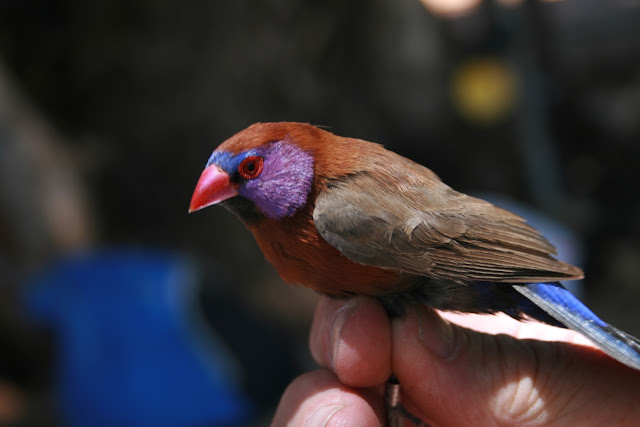There’s
no hiding it anymore: the major academic ornithological societies, e.g. The
American Ornithological Union, The Wilson Ornithological Society, The Cooper
Ornithological Society, and smaller raptor groups, are facing declining
membership numbers and reduced revenues.
These groups are currently in the midst of talks about forming a
singular society so as to pool resources and reduce inefficiencies due to
overlapping functions.
Importantly, the decline in the groups also reflects a similar, though
less drastic, proportion of research biologists performing research on natural
populations. While species such as
the Darwin’s Finches continue to receive much press, the fields of evolutionary
biology and behavioral ecology have diversified into new groups.
This
diversification is welcome; we can test overarching biological principles in
more species and some of the new work is done on species that are amenable to
controlled studies in labs.
Therefore, the appropriate response of academic ornithologists is not to
resent the burgeoning work on species such as Dictyostelium discoideum; rather, academic ornithologists should
turn their attention to the genetic and mutational techniques that have been
developed in the microbial and agricultural worlds. The DNA sequencing technology now available to researchers
is staggering; we can sequence billions of base pairs of DNA in less than a few
days. Other groups of researchers
have used this data to characterize soil meta-communities, identify mutations
in agricultural crops, and delimit the mutations associated with coat color in
some mouse species.
Not
only are these techniques providing truck-loads of data, they are also being
refined by the researchers performing the techniques. The researchers have worked out most of the kinks associated
with common next-generation sequencing technology thus delivering to ornithological
researchers a massive opportunity that should not, and can not, be wasted. The reasons that first attracted
researchers to studying birds are the same reasons that should be used to
create a mini-rebirth in academic ornithology.
For
instance, the biological community has gravitated towards studying sexual
selection in birds because of the wealth of color traits and behavioral traits
that are supposedly due to sexual selection. As referenced before, Darwin’s finches are a classic example
of species radiation (as an aside, Darwin didn’t even realize the finches were
all finches until he had an ornithologist friend examine the specimens), and a
considerable number of bird species are studied because of their cooperative
breeding behaviors.
Until
recently, serious genetic studies could only be conducted on “model” species
that were both reared in labs and also had their genome sequenced and
published. Now, a host of
enzymatic digestion and sequencing allow researchers to discover large swaths
of the genome at a time. And in
some cases, these DNA sequences can be mapped onto the genome of a closely
related species; for example, individuals working on Darwin’s finches could map
sequences onto the genome of the zebra finch.
What
does all this mean? First, we can begin to understand the genetic architecture
that underlies the variety of bird colors we see. We would be able to compare tanagers and Northern Cardinals
to see if selection produced red feather color along similar molecular
pathways. We will be able to
delimit the genes that underlie behaviors like cooperative breeding, whereby
some individuals give up the opportunity to breed elsewhere and instead help
raise their siblings or half-sibs.
Once
we define these genes that are correlated with certain morphological or
behavioral traits, it won’t be long before researchers can insert mutations or
new forms of a gene into wild individuals using vectors such as viruses. Field experimentation/validation is
considered the holy grail of field biologists, and in the near future
ornithologists will be able to perform the studies that conclusively show that
certain genes are responsible for certain traits. Once we understand which genes control which traits, we can
follow those genes over time and track evolution in real time in animal
species.
In
total, the depth and breadth of our understanding of the natural world will
grow exponentially. The only
necessary step is for ornithologists to catch-up with the technology that is
coming online. Regrettably, many
ornithologists are only familiar with the new techniques, but hesitant to dive
into the new world of next-generation sequencing. This is disconcerting as the potential data that could be
collected and analyzed on bird species would firmly entrench ornithology as a
relevant and exciting field of biology.
Indeed, there is no reason why the bird traits that have drawn both
researchers and the public to birds in the past, can’t be studied and understood
using the new technology we have now.
Importantly, if academic ornithologists do take advantage of the
opportunities presented by new sequencing technology, then we could reverse
declining membership in bird societies and potentially engender a new renaissance
in birding.
Gavin is a PhD candiate at the University of Miami studying cooperative behavior in Sociable Weavers. To learn more about Gavin, see our Guest Writers page.
We at BoomCha are excited and hopeful to hear from you. Please comment on this post with your thoughts, concerns, and opinions on Gavin's piece.
Gavin is a PhD candiate at the University of Miami studying cooperative behavior in Sociable Weavers. To learn more about Gavin, see our Guest Writers page.
We at BoomCha are excited and hopeful to hear from you. Please comment on this post with your thoughts, concerns, and opinions on Gavin's piece.









